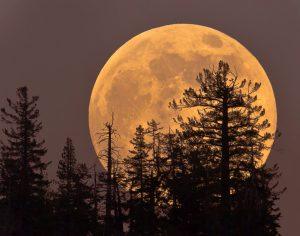Posted by Maeve on Monday, Oct 22, 2018

Have you noticed moon recently? It will be full this Wednesday. It's a Hunter's Moon, (though with harvest delay it might be called a Harvest and Hunter's Moon).
According to the website EarthSky "every full moon has many names, and most are tied to months of the year. But some moon names are tied to seasons, such as the Harvest and Hunter’s Moons. The Harvest Moon is the full moon closest to the autumnal equinox. The Hunter’s Moon is the full moon after the Harvest Moon. The 2018 autumnal equinox was on September 22-23 and the Harvest Moon was around September 24-25. So the upcoming full moon – on the night of October 24, 2018 – is the Hunter’s Moon.
What makes a Hunter’s Moon unique?
Nature is particularly cooperative around the time of the autumn equinox to make the fall full moonrises special. On average, the moon rises about 50 minutes later each day. But when a full moon happens close to the autumnal equinox – either a Harvest or a Hunter’s Moon – the moon rises only about 30 to 35 minutes later daily for several days before and after the full moon. The reason is that the ecliptic – or the moon’s orbital path – makes a narrow angle with the evening horizon around the time of the autumn equinox. The result is that there’s a shorter-than-usual lag time between successive moonrises around the full Hunter’s Moon.
These early evening moonrises are what make every Hunter’s Moon special. Every full moon rises around sunset. After the full Hunter’s Moon, you’ll see the moon ascending in the east relatively soon after sunset for several days. The moon will be bright and full-looking for several nights beginning around October 23 or 24.
The narrow angle of the ecliptic means the moon rises noticeably farther north on the horizon from one night to the next. So there is no long period of darkness between sunset and moonrise, and, around the time of full moon, many people see the moon in a twilight sky.
How did the Hunter’s Moon get its name? There are many different explanations for the name Hunter’s Moon. In the autumn there is not long period of darkness between sunset and moonrise for several days in a row, around the time of full moon. Before there were tractors or tractors with lights, the glow of the Harvest Moon helped farmers to gather their crops. As the sun’s light faded in the west, the moon would soon rise in the east to illuminate the fields throughout the night. A month later, after the harvest was done, the full Hunter’s Moon was said to illuminate the prey of hunters, scooting along in the stubble left behind in the fields."
I love to watch the night sky, do you?

